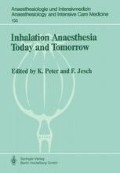Abstract
So much has been written about techniques for the anaesthetic management of patients undergoing open-heart surgery, that the principles of proper anaesthetic use are often forgotten. In the anaesthetic management of the cardiac surgical patient it is extremely important to know the pathophysiology of the cardiovascular lesion and the functional condition of the myocardium [17]. The broad range of anaesthetic drugs tolerated by the diseased heart makes the choice of anaesthetic far less important to the patient than the care with which it is administered.
Access this chapter
Tax calculation will be finalised at checkout
Purchases are for personal use only
Preview
Unable to display preview. Download preview PDF.
References
Bassell GM, Lin YT, Oka Y, Becker RM, Frater RWM (1978) Circulatory response to tracheal intubation in patients with coronary artery disease and valvular disease. Bull NY Acad Med 54:842–848.
Bland JHL, Lowenstein E (1976) Effect of halothane on myocardial ischaemia. Anesthesiology 45:287–293.
Braunwald E (1971) Control of myocardial oxygen consumption. Physiologic and clinical consideration. Am J Cardiol 27:416–432.
Cohn JM (1973) Blood pressure and cardiac performance. Am J Med 55:351–361.
Dowdy EG, Kaya KL (1968) Studies of the mechanism of cardiovascular responses to ketamine. Anesthesiology 29:931–943.
Eger El, Smith NT, Stoelting RK, Cullen DJ, Kadis LB, Whitcher CE (1970) Cardiovascular effects of halothane in man. Anesthesiology 32:396–409.
Ellrodt G, Chew CYC, Singh BN (1980) Therapeutic implications of slow-channel blockade in cardiovascular disorders. Circulation 62:669–679.
Epstein SE, Kent KM, Goldstein RE, Borer JS, Redwood DR (1975) Reduction of ischaemic injury by nitroglycerin during acute myocardial infarction. New Engl J Med 292:29–35.
Hoffman JIE (1978) Determinants and prediction of transmural myocardial perfusion. Circulation 58:381–391.
Gobel FL, Norstrom LA, Nelson RR (1978) The rate-pressure product as an index of myocardial oxygen consumption during exercise in patients with angina pectoris. Circulation 57:549–555.
Greenberg BH, DeMots H, Murphy E, Rahimtoola SH (1981) Mechanism of improved cardiac performance with arteriolar dilators in aortic insufficiency. Circulation 63:263–268.
Johnson RA, Zir LM, Harper RW, Leinbach RC, Hutter AM Jr, Pohost GM, Block PC, Gold HK (1979) Patterns of haemodynamic alteration during left ventricular ischaemia in man. Relation to angiographic extent of coronary artery disease. Br Heart J 41:441–451.
Kotter V, von Leitner ER, Wunderlich J, Schroder R (1977) Comparison of haemodynamic effects of phentolamine, sodium nitroprusside, and glyceryl trinitrate in acute myocardial infarction. Br Heart J 39:1196–1204.
Lappas DG, Buckley MJ, Laver MB, Daggett WM, Lowenstein E (1975) Left ventricular performance and pulmonary circulation following addition of nitrous oxide to morphine during coronary artery surgery. Anesthesiology 43:61–69.
Lappas DG, Geha D, Fischer JE, Laver MB, Lowenstein E (1975) Effect of large doses of intravenous morphine upon filling pressures of the heart and pulmonary circulation of patients with coronary artery disease. Anesthesiology 42:153–159.
Lappas DG, Lowenstein E, Waller J, Fahmy NR, Daggett WM (1976) Haemodynamic effects of nitroprusside infusion during coronary artery operation in man. Circulation [Suppl III] 54:III4.
Lappas DG, Powell JW, Daggett WH (1977) Cardiac dysfunction. Anesthesiology 47:117–135.
Lowenstein E, Hallowell P, Levine FH, Daggett WM, Austen WG, Laver MB (1969) Cardiovascular response to large doses of intravenous morphine in man. N Engl J Med 281:1389–1393.
Nies AS, Shand DG (1975) Clinical pharmacology of Propranolol. Circulation 52:6–12.
Ogilvie RI (1978) Effect of nitroglycerin on peripheral blood flow distribution and venous return. J Pharmacol Exp Ther 207:372–380.
Robinson BF (1967) Relation of heart rate and systolic blood pressure to the onset of angina pectoris. Circulation 35:1073–1083.
Smith NT, Eger EI, Stoelting RK, Whayne TF, Cullen D, Kadis LB (1970) The cardiovascular and sympathomimetic responses to the addition of nitrous oxide to halothane in man. Anesthesiology 32:410–421.
Stanley TH, Stanford W, Armstrong R, Cline R (1973) The effects of high dose morphine are fluid and blood requirements in open-heart operations. Anesthesiology 38:536–541.
Stanley TH, Stanford W, Armstrong R, Cline R (1974) The effect of morphine anesthesia in blood requirements during and after valve replacement and coronary artery bypass grafting. Ann Thorac Surg 17:368–376.
Stoelting RK (1972) Haemodynamic effect of gallamine during halothane nitrous oxide anesthesia. Anesthesiology 36:612–615.
Stoelting RK, Gibbs PS (1973) Haemodynamic effects of morphine and morphine nitrous oxide in valvular heart disease and coronary artery disease. Anesthesiology 38:45–52.
Stoelting RK, Reiss RR, Longnecker DE (1972) Haemodynamic response to nitrous oxide-halothane and halothane in patients with valvular heart disease. Anesthesiology 37:430–435.
Wong KC, Martin WE, Hornbein TF, Freund FG, Everett J (1973) The cardiovascular effects of morphine sulfate with oxygen and nitrous oxide in man. Anesthesiology 38:542–549.
Editor information
Editors and Affiliations
Rights and permissions
Copyright information
© 1982 Springer-Verlag Berlin Heidelberg
About this chapter
Cite this chapter
Lappas, D.G. (1982). The Anaesthetic Management of Coronary and Cardiac Surgery. In: Peter, K., Jesch, F. (eds) Inhalation Anaesthesia Today and Tomorrow. Anaesthesiology and Intensive Care Medicine / Anaesthesiologie und Intensivmedizin. Springer, Berlin, Heidelberg. https://doi.org/10.1007/978-3-662-39944-6_11
Download citation
DOI: https://doi.org/10.1007/978-3-662-39944-6_11
Publisher Name: Springer, Berlin, Heidelberg
Print ISBN: 978-3-662-38979-9
Online ISBN: 978-3-662-39944-6
eBook Packages: Springer Book Archive

